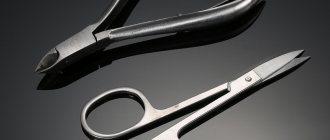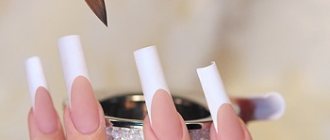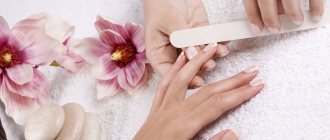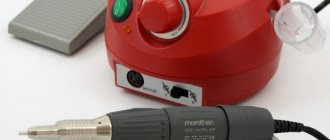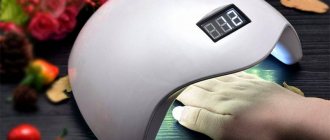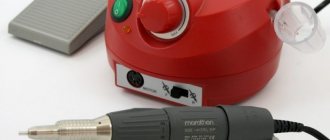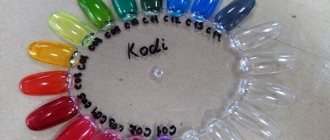Areas of application
It is difficult to imagine a more multifunctional tool than a wooden stick. It can be used in extensions, design and manicure. The tool is most often used in the following areas:
- Cleaning your nails. In this case, we mean removing dirt from under the free edge of the nail. To do this, use the pointed end of a stick;
- Pushing the cuticle is one of the main areas of use. An orange manicure stick, as in the photo, is very popular when performing unedged European manicure. This is one of the safest tools for this purpose, as it will not damage the nail plate. Not the cuticle itself;
- Cleaning the cuticle from the nail plate after it has been softened with a remover is also easily done with this tool. The ptegirium can also be easily scraped off. This tool is preferred for these purposes also for security reasons;
- This tool is also indispensable when doing nail extensions. They can be used when gluing tips and forms. In addition, they are sometimes used directly for laying gel on forms;
- Removing shellac and gel is also not complete without such a stick. After the coating material is softened by special means, its remains are scraped off with such a stick;
- Decorating nails is also often not complete without the use of sticks. They are used for applying and moving small elements across the plate, smoothing stickers, etc. Some even manage to use them for painting.
Many other ways to use this tool in manicure remained unmentioned. For example, such a stick can replace a needle when painting on wet varnish. If you buy sticks with a pointed cone, you can also replace them with medium-diameter dots.
Selection and Features
An orange nail stick will only be able to reveal all its functionality when you choose one that will be convenient for you to work with. The sticks differ in both width and length. In width, they can have a diameter from 3 to 5 mm, and in length from 9 to 18 cm. Some sticks have colored coating on the ends, but this is more a matter of the external attractiveness of the instrument than its functionality. In addition, there are sticks with a rubber tip that are suitable for removing the thinnest and most sensitive cuticles.
Remember that all such sticks are disposable. First of all, this is so because they cannot be sterilized or disinfected, since such procedures with wood will either be ineffective or even lead to damage to the instrument. When moving the cuticle or cleaning dirt from under the nail, there is a possibility of causing injury or microtrauma to yourself. Bacteria from a dirty stick will easily enter the wound and cause inflammation.
Orange sticks for manicure.
Author: Tanusha
Rate this article: (5 votes, average: 5.00 out of 5) Loading…
Now we will look at such an integral element of the manicure world as orange sticks. They were invented in France and have become an important part of manicure tools. Without these simple sticks, it is now difficult to imagine some manicure procedures. They received this name due to the material from which they are made - orange wood. Why orange? It’s just that this tree not only gives oranges, but itself has a soft but dense structure, which does not allow the sticks to delaminate and injure the nail. Another important property of wood is that it has excellent antiseptic properties, which is important for manicure. Let's take a closer look at what orange sticks are used for in the manicure process and how to use them correctly.
An orange stick is a thin stick made from the wood of the orange tree, one end of which has a pointed nose and the other is flat. You can easily shape the stick using a coarse abrasive file. Its use is the key to a neat and gentle manicure.
What is an orange stick used for in manicure?
1. To clean your nails. They can easily clean the inner surface of the nail plate. To do this, just run the pointed end under the nail. Accumulated dirt must be removed immediately or the sticks themselves must be changed more often.
2. To push back the cuticle. The orange stick is the main tool for European unedged manicure. It is used in it to push back the cuticle from the nail plate. You can also push back the cuticle with other tools using a metal or rubber spatula, but this can scratch the nail or tear the cuticle (which in turn will lead to the formation of hangnails), and it is also extremely unhygienic! This can be easily avoided by simply using an orange stick to push back the cuticle. After all, the material from which it is made glides pleasantly over the skin in an area of increased sensitivity.
3. To remove cuticle. They easily cope with cuticle removal. Simply, after softening with a special product, carefully pry the keratinized cuticle cells with a pointed edge and separate these tissues from the main layer of the cuticle. It is important here that it is well softened, then removing excess cells with an orange stick will not be difficult.
4. In nail extensions. In extensions, they are used both for sticking tips and laying out forms from biogel and acrylic, and in the procedure for removing artificial nails. When the acrylic softens, it is easy to remove using this manicure tool.
5. For decorating nails. To apply small objects to the nail and make a manicure with decorations - sparkles, rhinestones, appliques, then orange sticks are an indispensable thing here. It can also be used to paint nails with varnish.
A few useful rules
1. First, choose those that will be convenient for you to use, because there is also variety here. They come in different lengths - from 9 to 18 centimeters, and widths - from 3 to 5 millimeters. There are special sticks with the ends coated in different colors. Some people prefer plastic chopsticks with a rubber tip. They are used for exactly the same purposes, but are not as useful and are more suitable for thin cuticles.
2. It is better not to reuse an orange stick, as it absorbs moisture very well, but is difficult to disinfect. Therefore, reuse of this manicure tool is highly undesirable. This is more of a one-time and individual item that is not worth skimping on. And in order not to run into a fake, buy orange sticks only in specialized cosmetics stores.
The price of the package ranges from 20 to 300 Russian rubles (depending on their quantity in the package and length).
After such a long post, it’s worth relaxing a little, smiling, and reading the thematic joke:
“Long nails won’t fit into your pocket.”
If you found this page useful, please recommend it to your friends:
moi-manikur.ru
Manufacturing
Orange sticks appeared in the second half of the 20th century in France and quickly gained popularity due to their high versatility and ease of working with them. An orange manicure stick is a fairly cheap tool compared to others, because the price of a set can range from 20 to 200 rubles. It depends on the number of sticks, their size, length, and decorative elements.
Why did they choose the orange tree to make manicure tools? It combines a number of excellent properties and useful qualities. Its wood is quite dense and strong, which prevents it from breaking or absorbing too much liquid, and the stick does not delaminate when finished. At the same time, the wood is soft, which means it does not injure the nail. The antiseptic properties of this wood reduce the likelihood of inflammation developing at the site of microtraumas.
Working with chopsticks
The most popular procedure performed using orange sticks is moving and removing the cuticle. This is a fairly simple process, which, however, has a number of nuances and features. Therefore, we will tell you a little more about how to remove cuticles with an orange stick.
Before starting the process, you need to make a hot bath for your hands, which will soften the cuticle and make it easier to move away from the bed. After finishing the bath, dry your hands with a towel and begin treating the cuticle.
Using the pointed end of the stick, begin to move the cuticle in the direction from the free edge of the nail to the pre-nail fold. In this case, the movements should be sliding; there is no need to try to lift the cuticle or put excessive pressure on the nail growth area, as this can damage it. In this case, the direction of movement horizontally of the nail should also be directed in one direction, for example, from left to right.
Don't start pushing the cuticle away from the center. Move from the edge of the nail, from the side pre-nail fold, to the center of the nail, and then from the center to the other edge. After you have pushed back the cuticle in the lunula area in this way, begin to move the excess skin along the edges, near the pre-nail ridges. Then try to clean off the ptegirium where it remains without pressing on the nail.
In order to always have well-groomed hands, every girl or woman puts maximum effort into this; those who have the time and money to regularly use the services of a manicurist, and those who cannot afford such luxury, try to do it themselves.
Orange sticks for manicure. How to use?
In order to always have well-groomed hands, every girl or woman puts maximum effort into this; those who have the time and money to regularly use the services of a manicurist, and those who cannot afford such luxury, try to do it themselves.
Orange sticks for manicure
Among the numerous devices that are necessary for nail care, you should pay attention to wooden sticks made from orange tree wood. I would like to note that modern manicure was invented by the French, and they were the first to use orange sticks and complete manicure sets with them.
The question immediately arises, why from orange or, say, not from oak, poplar or any other type of wood? Everything is very simple here. The fact is that in addition to the fact that the tree generously gifts us with these tasty and aromatic fruits, the wood itself is also useful; its structure is quite dense, but soft, so the finished sticks do not delaminate and do not injure our nails. In addition, wood has antiseptic properties, which, by the way, is a must when performing a manicure.
Why orange wood sticks?
So, we have found out why orange wood is used for sticks, now we will look in more detail at what and how these sticks are used.
In appearance, these are ordinary sticks, only on one side there is a pointed nose, and on the other it has a flat shape. Using a coarse abrasive file, you can restore the shape of the stick. Orange sticks vary in length, their size ranges from 9 to 18 cm, but their thickness ranges from 3 to 5 mm.
On sale you can find the same sticks, but with multi-colored coating on the tips, or even sticks with a rubber tip, they are also designed for removing thin cuticles.
It is worth remembering that orange sticks absorb moisture well; after use, they cannot be treated with antiseptics, so with each new procedure you should take a new stick.
Why do you need an orange stick?
Using a stick, you can clean the inner surface of the nail; for this procedure, the pointed edge of the stick is used. The accumulated dirt on the stick is removed; during this procedure, do not forget to change the sticks.
Sticks are especially in demand when performing European fashion manicure, because... in this case, the cuticle is not cut, but carefully pushed away from the nail plate. To carry out this procedure, relaxing baths or special products for working with the cuticle are used.
In this case, you can use a metal or rubber spatula, but there is a possibility of damage to the cuticle itself. Using sticks is another matter; with the help of the blunt part you can gently push back the cuticle, without causing an infection, you can avoid inflammation and the formation of hangnails.
There are situations when, after the softening process, the keratinized cuticle cells must be removed. Here again, by the way, the pointed end of an orange stick is perfect. The main thing is not to forget to soften the skin before the procedure. Using gentle movements, pry up the keratinized edge of the cuticle and separate it from the main layer.
- Decorating your nails with an orange stick
Using a stick you can apply rhinestones, applique elements and sparkles. They also use a stick for painting with varnish.
Orange sticks are actively used in the extension procedure. With their help, softened acrylic is removed, and with the help of these wonderful sticks, tips are glued; they are also used when laying out forms from acrylic and biogel.
Margarita Vlasova for https://beautyhill.ru
beautyhill.ru
Orange sticks for manicure
Among the many devices that are needed, you should pay attention to wooden sticks made from orange tree wood. I would like to note that the modern version was invented by the French, and they were the first to use orange sticks and complete manicure sets with them.
The question immediately arises, why from orange or, say, not from oak, poplar or any other type of wood? Everything is very simple here. The fact is that in addition to the fact that the tree generously gifts us with these tasty and aromatic fruits, the wood itself is also useful; its structure is quite dense, but soft, so the finished sticks do not delaminate and do not injure our nails. In addition, wood has antiseptic properties, which, by the way, is a must when performing a manicure.
Why orange wood sticks?
So, we have found out why orange wood is used for sticks, now we will look in more detail at what and how these sticks are used.
In appearance, these are ordinary sticks, only on one side there is a pointed nose, and on the other it has a flat shape. Using a coarse abrasive file, you can restore the shape of the stick. Orange sticks vary in length, their size ranges from 9 to 18 cm, but their thickness ranges from 3 to 5 mm.
On sale you can find the same sticks, but with multi-colored coating on the tips, or even sticks with a rubber tip, they are also designed for removing thin cuticles.
It is worth remembering that orange sticks absorb moisture well
, after use, they cannot be treated with antiseptics, so with each new procedure you should take a new stick.
What are orange sticks
Not all orange sticks are created equal. They are distinguished by size, length, and of course cost. Depending on the chosen orange sticks, their diameter can range from 3 to 5 mm. Which stick the master will use depends on the nail plate the master will be working with. In addition to cleansing nails, orange sticks are also used when it is necessary to apply designs to the nail plate. Manufacturers offer their customers two types of sticks - made of wood and plastic. Plastic sticks, often sold with rubber tips, can be sterilized. When it comes to wooden orange sticks, they have a number of advantages that are worth paying attention to. These include:
- a wooden orange stick glides better over the surface, so you can make simple drawings quite quickly;
- It’s easy to work with orange sticks;
- the sticks do not injure the client’s skin and nails;
- the stick does not delaminate during operation;
- favorable price.
When choosing orange sticks with coating, it is worth remembering that it has an aesthetic function, but after they are used, they need to be thrown away. You can no longer use this wand on another client. All of the listed nuances should be paid attention to when choosing and purchasing orange sticks.
Why do you need an orange stick?
- Cleaning your nails
Using a stick, you can clean the inner surface of the nail; for this procedure, the pointed edge of the stick is used. The accumulated dirt on the stick is removed; during this procedure, do not forget to change the sticks.
- Working with the cuticle
Sticks are especially in demand when performing European, because in this case, the cuticle is not cut, but carefully pushed away from the nail plate. To carry out this procedure, relaxing baths or special products for working with the cuticle are used.
In this case, you can use a metal or rubber spatula, but there is a possibility of damage to the cuticle itself. Using sticks is another matter; with the help of the blunt part you can gently push back the cuticle, without causing an infection, you can avoid inflammation and the formation of hangnails.
- Cuticle removal
There are situations when, after the softening process, the keratinized cuticle cells must be removed. Here again, by the way, the pointed end of an orange stick is perfect. The main thing is not to forget to soften the skin before the procedure. Using gentle movements, pry up the keratinized edge of the cuticle and separate it from the main layer.
- Decorating your nails with an orange stick
Using a stick you can apply rhinestones, applique elements and sparkles. They also use a stick for painting with varnish.
- Nail extensions
Orange sticks are actively used in the extension procedure. With their help, softened acrylic is removed, and with the help of these wonderful sticks, tips are glued; they are also used when laying out forms from acrylic and biogel.
Orange manicure sticks are thin wooden sticks, usually with a pointed nose at one end and a flat nose at the other. An orange stick helps to do a manicure neatly and carefully. Buying an orange stick for a monitor is not difficult, you can order it in our Commelina online store.
Orange manicure sticks were invented in France and quickly became an integral part of manicure tools. Nowadays, it’s hard to imagine some of the most important manicure procedures without an orange stick. This stick is made from orange wood, which is how it got its name. Due to the peculiarity of this tree, the stick has a soft but dense structure, this does not allow the sticks to delaminate and contributes to the safety of the nail. In addition to its special structure, orange tree wood has good antiseptic properties, which is important for manicure. If you decide to buy orange sticks, read the information about them first.
Let's take a closer look at what orange manicure sticks are used for and how to use them correctly.
Why is an orange stick used in manicure?
1. Cleaning your nails. Using an orange manicure stick, you can very easily clean the inner surface of the nail plate. To do this, use the pointed end of an orange stick. After this procedure, the dirt accumulated on the shelf must be immediately removed.
2. Pushing back the cuticle. The orange stick is the main tool for European unedged manicure. It is used in it to push the cuticle away from the nail plate without harming the nail and the cuticle itself. If you use other tools for this purpose, for example, a metal or rubber spatula, this may scratch the nail or tear the cuticle. An orange stick allows you to avoid this; moreover, its antiseptic properties make the manicure more hygienic and safe.
3. Cuticle removal. After the cuticle has been softened with a special product, the keratinized cuticle cells are carefully pryed up with the pointed end of an orange stick and they are easily separated from the main layer of the cuticle. It is important that the cuticle is well softened, then removing excess cells with an orange stick will not be difficult.
4. Removing gel polish. In this process, the orange stick helps to remove the remaining gel polish without harming the nail, without damaging the nail plate. If you have bought or are going to buy an orange stick, it will help you out more than once.
5. Nail extensions. In extensions, an orange stick is used for gluing tips, laying out forms of biogel and acrylic, and also when removing artificial nails. The softened acrylic is easily removed with an orange wood stick.
6. Nail decoration. An orange stick is used to paint nails with varnish. It is also convenient for her to apply small objects to the nail to decorate the manicure with sparkles, rhinestones and appliqués.
What types of orange sticks are there? And how to choose?
You should choose a wand based on convenience. They come in different lengths (9 to 18 centimeters) and widths (3-5 millimeters). There are sticks with colored coating on the tip. In addition, some people prefer plastic sticks with a rubber tip to natural wood sticks. Which can be used for the same purposes, but they are less useful and are usually suitable for thin cuticles.
An orange stick made of natural wood is a disposable product; it is better not to use it several times, as it absorbs moisture very well and is difficult to disinfect.
And to avoid counterfeits, buy orange sticks only in
One of the popular methods - pushing back the cuticle with an orange stick - is used if the cuticle is thin and has recently grown. It helps to temporarily free keratinized skin from hangnails, and is used more often for unedged manicures.
This is the right approach when caring for your cuticles. If this is not done, the nails may take on a deformed appearance. Hard cuticles can crack and cause infection. Therefore, it is necessary to move the cuticle back during manicure.
What are orange sticks for?
To ensure that the purchased sticks serve you for a long time, pay attention to the information on the packaging regarding storage rules. A professional nail technician can use orange sticks in the following ways:
- cleansing - for this, use the pointed side of the stick; it can be used to remove accumulated dirt under the nails;
- Using orange sticks you can remove the top layer of the nail plate. To do this, one of the ends is soaked and the nail is cleaned;
- To get rid of the cuticle without cutting it, you will need orange sticks. This tool does not injure the nail and quickly removes excess skin;
- use when drawing. They can be used to draw a picture, or you can apply rhinestones and glitter using sticks;
- Professional nail technicians also use sticks in the process of nail extensions. Using a stick, you can remove acrylic, stick tips and lay out various forms when working with biogel and acrylic.
Many nail technicians replace orange sticks with a pusher, but this tool requires constant treatment and is prohibited from being used several times in a row.
Which is better: moving away, dissolving or removing
There are three known ways to remove the cuticle (skin pre-nail fold): cutting, pushing back, dissolving. Pushing back is present in any type of manicure. But if in the trimming version this is one of the stages on the way to cutting off the skin ridge, then in is the main condition. From an aesthetic point of view, of course, circumcision during manicure looks more tempting. The length of the nail increases, and the varnish on it looks beautiful, emphasizing its well-groomed appearance.
For those with thick, thick cuticles, the trimming method is a real salvation in the full sense of the word. It is necessary for the prevention of inflammatory processes, the formation of hangnails, and the appearance of other problems of the nail plate. But circumcision stimulates increased growth of the skin fold and is sometimes accompanied by cuts or microtraumas, which, in turn, can also provoke an inflammatory process.
Dissolution allows you to remove the cuticle using an expensive but effective remover. It is considered environmentally friendly, but requires the correct approach and application. Despite the speed and effectiveness, the use of the product has a number of nuances. If you overexpose it or use it frequently, you can injure the bed of the nail plate, and over time even destroy it. Therefore, the optimal amount of use is no more than 2 times a week.
Against this background, pushing back looks like the most gentle, harmless method that eliminates the occurrence of infections with inflammation. The presence of a skin roll means protecting the nail from external influences and providing the necessary nutrition and hydration. In addition, retraction slows down the growth of the skin pre-nail fold. But the most interesting observation is that the polish on the nail plate with uncut cuticles lasts better and longer.
Selecting the required tool
To push back the cuticle, use different tools: a metal or rubber spatula, as well as an orange wooden stick. The latter is the most popular and basic tool of European manicure. A double-sided orange stick is a disposable item, averaging 9–18 cm in length, used for pushing away. Its structure is soft, dense, and has antiseptic properties. This is a thin stick with pointed and flat ends. Unlike others, this instrument is the most hygienic and less traumatic. Doesn't scratch the nail, doesn't tear the cuticle. You can change the shape of an orange stick using a coarse abrasive file. To move away, use the blunt tip of the stick, and the sharper tip is used to clean the dirt under the nails, remove acrylic or apply decor.
A reusable spatula made of medical steel with different edges is the most common tool in manicure. It is often called a pusher (scraper). It may well replace an orange stick, as it adequately performs the same functions. Does not require sharpening, but must be disinfected by boiling or treatment with aseptic means. When using a metal tool, the likelihood of nail damage increases significantly, so spatulas with rubber tips are often used.
New products designed for working with cuticles include a special pencil. Multifunctional tool. It is also used to move back the preungual skin fold. This is done using a capillary. At the same time, oil is applied to the skin roll that is moved away. After this, the shape of the nails is created using the pencil cap. The tool is quite safe and suitable for non-professional use.
How to replace an orange nail stick
An orange stick is successfully replaced by such manicure attributes as a pusher (scraper) and a laser file.
- A pusher, or scraper as it is also called, is a double-sided metal accessory. On one side there is a kind of spatula intended for pushing back the cuticle, on the second there is a so-called hatchet for cleaning the nail bed and ridges. In addition to the hatchet, the end can be topped with a curette or spear. The tool is sharpened in such a way that you will not get hurt during a manicure, but it does its job very effectively. Improved models are equipped with a slingshot knife.
Unlike an orange stick, instruments made of medical steel can be easily disinfected and are therefore reusable. In general, they cope with all the functions of an orange wood stick with a bang. The disadvantages of pushers and scrapers are the cost and risk of injury to the nail plate. These two points make them lose to a wooden rod.
- Another alternative in recent years is a laser cuticle file, which is a cross between a classic edged and European unedged manicure. Laser safe coating and compact size are the undoubted advantages of this cuticle treatment method. Manufacturers guarantee a long service life, up to a decade. In terms of cost, this beauty gadget is classified as affordable, but high-quality branded accessories will cost much more.
Now you know how to properly use an orange manicure stick. Its wide range of applications and low price make it popular among masters and girls who prefer to carry out the procedure on their own, and make it a leader among analogues. Appreciate its benefits by trying to create a manicure using an orange stick. You will not only get neat, healthy nails, but also enjoy an attractive citrus aroma!
We carry out the procedure ourselves
The main function of the skin pre-nail fold is protective. But an unkempt, overgrown, overdried cuticle becomes a possible source of inflammation. Its dead particles stick to the nail plate, thereby slowing down the growth of the nail. This can also significantly damage the nail surface. It is quite obvious that the cuticle needs to be carefully and carefully looked after, that is, it must be removed in a timely manner.
Removing the skin roll is the most accessible method of care for everyone. It is safe and allows you to do all the manipulations yourself without negative consequences for your nails and skin. With European manicure, pushing back is carried out using emollients without steaming. If the cuticle is damaged or infected, use an antiseptic cream, ointment or antibiotic. On the choice of products, as well as their use, you need to consult a cosmetologist. The standard option for moving a skin ridge with an orange stick includes a few steps:
- Remove nail polish with an acetone-free product, then wash your hands with soap.
- Make a warm bath for your hands with the addition of chamomile, lemon juice or softening essential oils.
- Dry your hands with a towel.
- Apply emollient to cuticles with a brush.
- Gently push the cuticle back to the base of the nail with an orange stick.
When the skin roll is completely pushed back to the base, the root of the nail becomes visible. The parts that remain unmoved should be corrected. The pre-nail skin fold can be pulled back after a shower or bath while your hands are damp and warm. It is advisable to do this procedure once a week. Ideally, the skin roll should be constantly soft and moisturized. The final well-groomed result is a smooth nail plate with a well-processed cuticle.
Absolutely all women know that orange manicure sticks are a must-have tool in the list of necessary accessories. This is a multifunctional item that makes nail care more convenient and safe!
The thin orange stick was invented by the French. Now the whole world is successfully using this simple item! The length of the instrument varies from 9 to 18 centimeters. Thickness - from 3 to 5 mm. One end of the stick is pointed, the other is blunt and beveled.
Benefits of orange wood manicure sticks
- The very name of the sticks comes from the material from which they are made - orange wood. You may ask why you can’t use any wood? The answer is obvious! The structure of orange wood is much softer. Accordingly, it does not injure the treated area.
- The material does not undergo delamination, which means the formation of sharp notches. This is another plus! The risk of injuring your nails and skin is minimal!
- The orange tree has been proven to have antiseptic properties. Therefore, small wounds and scratches on the skin will not become inflamed. This is an important advantage in manicure! But you certainly shouldn’t ignore other antiseptics.
- There are several types of orange sticks. For example, sticks with rubber tips are used for very sensitive skin. There are sticks with colored frames, which serve more of an aesthetic function.
Multifunctional orange manicure stick
Each manicure set contains such a multifunctional item as an orange stick . Why is it needed? What can replace it with and why are these sticks called orange?
The orange stick gets its name because it is made from orange wood. This breed does not flake, is durable, and is excellent for manicure procedures. This type of wood is also quite soft and is not capable of harming the surface of the nail and the skin around it. The products have a special shape. At one end the stick is flat and has a beveled edge, and at the other it is pointed like a toothpick.
Orange sticks for manicure: how to use the tool?
An orange stick is a very simple, but multifunctional item. The scope of application of the tool is quite wide. Let's look at the main functions and give important recommendations on how to use orange manicure sticks.
How are chopsticks used?
- To push back the cuticle.
For unedged (European) manicure, which is increasingly gaining popularity, this tool is indispensable! An orange stick is the best way to gently push back the cuticle without damaging the thin skin. Perform the procedure with the blunt end of a stick.
- Sometimes metal tools are used for these purposes. But it is known that the cuticle is very thin, and the base of the nail is a painful area. Therefore, any carelessness in movements can lead to the appearance of wounds on delicate skin and pain.
The orange stick is also used in Brazilian manicure.
- For removing cuticles.
Have you decided to use special softening agents to remove cuticles? An orange stick can be used to easily clean the base of keratinized cells without damaging the nail growth area. Proceed with removal only when you are sure that the cuticle has softened well. Carefully pry the layer with the rounded tip of the stick. Don't press too hard on the skin or overdo it. If the remnants of the cuticle are difficult to remove, then you should study the process technology well or replace the product with a more effective one.
- For removing gel polish.
The technique of cleaning a record from a durable coating requires removing the remaining product with a hard tool. Often inexperienced and impatient beginners scratch their nails. An orange stick will help you gently and carefully remove the gel polish without damaging the plates. Follow the instructions for using gel polish remover exactly. Clean the nail carefully, without haste.
- To clean the subungual space.
It is very convenient to use a stick to clean the free edge of any dirt that has accumulated there. This can be done with a sharp tip. It is useful to give your hands a warm bath before cleaning.
- For decorating the base.
With a thin stick it is convenient to pick up rhinestone beads and “sit” them on the glue. The sharp tip can be used to paint the surface of the plate. An orange stick is also used, for example, in caviar manicure to level out broths, as well as to create patterns on wet gel polish.
- When doing nail extensions.
The stick is used as an auxiliary tool for creating a shape, as well as for removing artificial plates.
How to use an orange manicure stick
How exactly to wield it in this or that case? Let's talk about this in order.
Cuticle removal
Using an orange stick in a manicure is traditionally used to get rid of cuticles. The cuticle is the skin that surrounds the base of the nail plate. The dead part is removed to create a neat appearance.
European manicure involves the abandonment of piercing and cutting instruments (nippers, tweezers) that are involved in the trimming technique. European care involves the use of a softening gel applied to the cuticle, which, in turn, is first pushed back with an orange stick.
After the proper time has passed, when the product acts on the skin, the cuticle is again removed with a wooden stick, without the risk of damaging the skin.
Cleaning your nails
Since the wooden stick has a beveled tip, it is convenient for removing dirt under the nails. The space under the free edge of the plate is very sensitive and painful. It is under no circumstances recommended to clean the area with sharp objects. Thanks to the antiseptic effect that a wooden tool has, the vulnerable area is additionally protected.
Also, when removing the decorative coating, you can use an orange stick to remove the remains of varnish or gel polish, this is clearly shown in the photo:
Nail decoration
In decoration, the orange manicure stick is a multifunctional assistant:
- Its pointed tip is useful when applying a pattern to the surface of the plate.
- A stick is convenient for gluing rhinestones, glitters, creating an applique, laying out broths, and distributing sparkles.
- For extended nails, a stick is necessary when laying out acrylic and biogel forms, tips and when removing softened acrylic.
How to use an orange stick to create designs on your nails - video
What should you keep in mind when working with orange sticks?
- Sticks made of natural wood absorb moisture along with small particles of dust and dirt. The item is difficult to disinfect. Therefore, they are not suitable for long-term use! The orange stick is considered a disposable tool. And purely individual! It is not recommended to use it for the next procedure!
- Sticks are most often sold in packages of several pieces. This allows you to change it in time if necessary, rather than running to the store for a new one.
- If there is a need to correct the shape of the stick, you can do this using a file with coarse abrasiveness.



